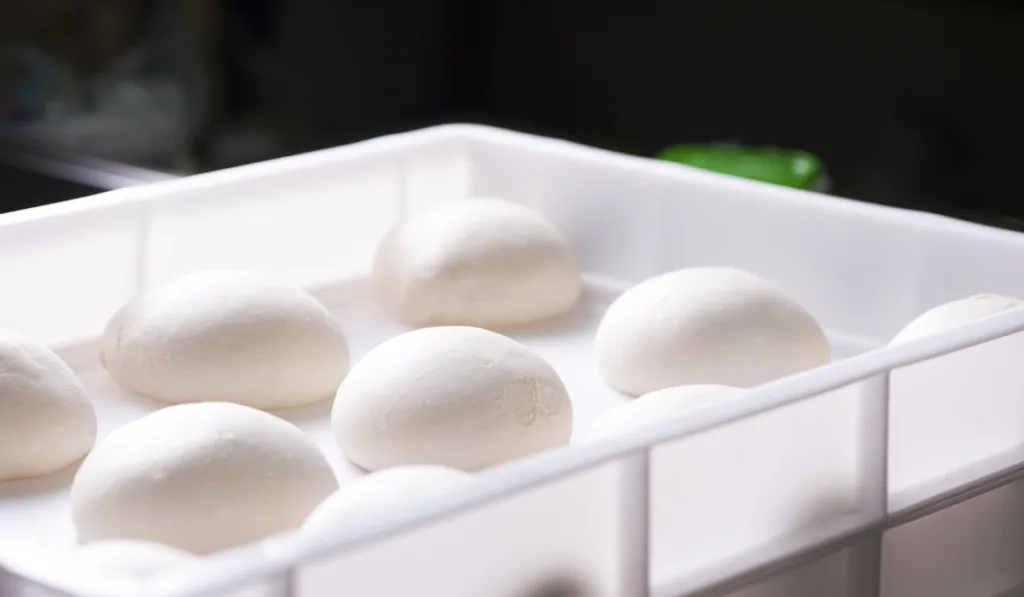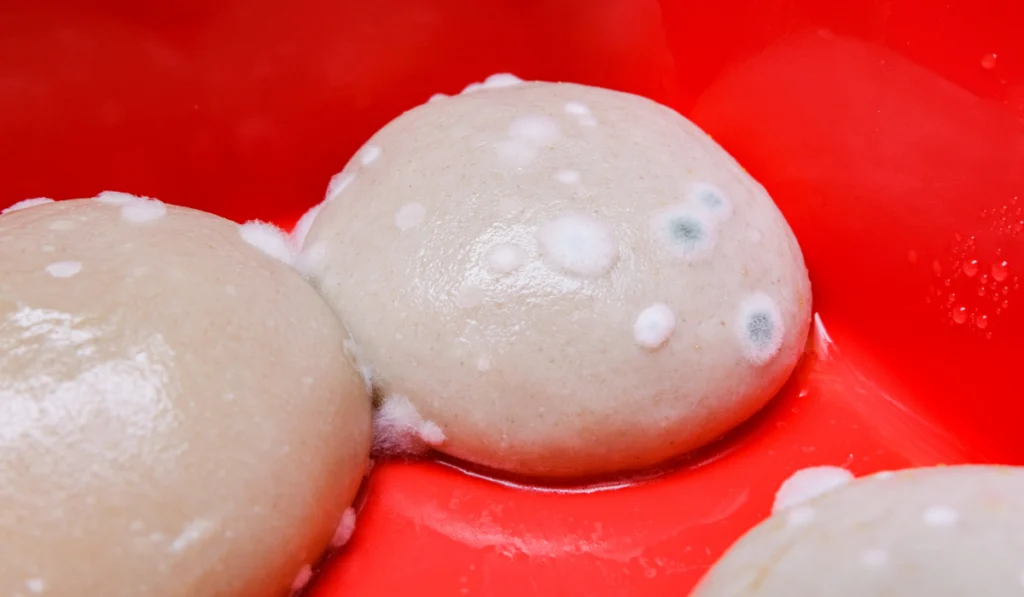From bread and pizza to pies and rolls, it is not uncommon to have batches of dough stashed away in the refrigerator or freezer that escaped your mind.
If this happens to you often, you have probably found yourself wondering whether dough goes bad in an attempt to reduce the waste that comes with discarding forgotten dough.
To finally put things to rest, this guide explores all there is to dough as far as shelf life is concerned.
Read on to find out more.

Table of Contents
Does Dough Go Bad?
Dough goes bad eventually, as is the case with most freshly made foodstuffs.
How long it takes to go bad ultimately depends on the ingredients you used in making the dough and how you are storing it.
For instance, the standard dough will only last for 5 to 10 days when refrigerated.
On the other hand, enriched dough containing eggs, milk, and butter will go bad within a few hours of being left in your kitchen at room temperature.
That being said, even the richest dough can last for a considerable amount of time under the right conditions as you will learn from this article.
| Type of Dough | Room Temperature | Refrigerator | Freezer |
| Yeast dough | This depends on the: *Amount of yeast in the dough. *Time required for the specific dough to rise. *Existing room temperature. | Slightly longer than on your kitchen counter because the yeast will rise at a slower rate. Roughly 5 to 7 days. | About 3 months. |
| Sourdough | For the first rise: *2 to 4 hours in warmth. *6 to 8 hours in a cold room. For the second rise: *1 to 2 hours. | Up to 14 hours. | Up to 4 weeks after the second rise to allow the wild yeast to develop. |
| Plain dough (Salt, water, yeast) | Roughly 12 hours in cool spaces. This time can vary depending on: *Amount of yeast you use. *The room’s temperature. | 5 to 7 days with close supervision. Refrigerating impacts the texture and flavor of plain dough positively. It, however, risks over-proofing the past 5 days, but it will still be safe for consumption. | Up to 3 months in the right conditions and after the first rise. |
| Rich dough (Eggs, yogurt, milk, or cream) | No more than 2 hours. | 3 to 5 days. It is, however, safest to consume within 48 hours. | Up to 1 month. However, using it in 2 to 3 weeks will give the best results. |
Signs of Bad Dough
Bad dough, in this case, refers to dough that is no longer safe for human consumption. Some of the telltale signs of bad dough include:
Rotten Smell
A foul or rotten smell is one of the most obvious signs that your dough is bad and not safe for consumption.
However, an unpleasant smell doesn’t always mean that your dough is bad or unsafe. This is because even fermented dough can emit a beer or an alcohol-like smell that many can mistake for dough going bad.
While differentiating these two smells comes with experience, fermented dough will mostly have a sour smell, which is normal while spoiled dough will have a rancid or cheese-like smell.
Color Change

Color change is another easy way to tell whether your dough has expired. Depending on the ingredients you have used, the normal dough has a white, beige-ish, or yellow color.
Therefore, if your dough has any other strange color like green or gray, it is because it has gone bad and is usually a result of mold or bacteria growth.
The enriched yellow dough will also change color and become yellower as it continues to go bad.
Textural Change
A change in texture can also mean that your dough is spoiled. This could be anything from developing lumps to becoming dry or hard.
This excessive drying can cause the dough to develop a chalky or powdery texture when left out for too long.
Lastly, spoiled dough may also have a slimy or sticky texture as a result of excess yeast or bacterial growth.
Freezer Burn
While freezing your dough is supposed to preserve and make it last longer, it also exposes it to freezer burn if not stored properly.
Freezer burn occurs when your dough forms ice crystals as a result of being in the freezer for too long. The ice crystals present as white spots on the somewhat dry or hard dough.
In most cases, allowing the dough to thaw at room temperature will help melt the crystals which in turn adds moisture to the dough making it more workable.
Freezer-burned dough is not ideal for baking as it is likely to have an off taste — unlike other signs, freezer burn simply means that your dough has been frozen for a long time, but it is not necessarily bad.
Mold

Mold growth is another obvious sign that your dough is not safe for consumption. Regardless of how much mold you can see on the surface of your dough, it should all be discarded.
Mold is highly toxic and can cause serious health complications when consumed. Hence the reason you should avoid the temptation of discarding the affected dough parts only.
How to Make Dough Last Longer?
If you are prone to making dough and leaving it out for long, these tips will help you prolong its shelf life.
Use the Right Flour
Contrary to what you may think, the type of flour you use affects the shelf life of your dough.
With this in mind, consider using bread flour or all-purpose flour for your dough since they store better than other flour types.
Proper Storage
Using the right flour will not matter if you do not store your dough properly. Always store your dough in a cool and dry place in a well-sealed, airtight Ziplock bag or container.
Remember to tightly wrap individual dough balls with plastic wrap before putting them in a Ziplock bag or airtight container for freezing.
Reduce the Amount of Yeast You Use
The amount of yeast you use directly influences how long your dough will be viable.
As a result, it is safer to reduce the amount of yeast a recipe calls for to ensure that your dough doesn’t overproof and even collapse during storage.

Tips to Consider When Storing Dough
These few reminders will help you throughout your dough storage process:
- Yeasted dough is prone to over-proofing when left out too long. This increases the chances of your dough collapsing in the oven and turning out dry.
- You can use your over-proofed plain dough to bake flatbread, like a pizza or focaccia, which doesn’t need much rise.
- The natural yeast in sourdough starters takes longer to rise than commercial yeast.
- Unlike plain dough, sourdough does not benefit from refrigerating as far as texture and flavor go.
- Over-fermented sourdough becomes sticky and wet which renders it unusable.
- To prevent over-proofing, consider punching down your plain dough when it doubles in size so that it can rise again.
Final Thoughts
There you have it, fellow bakers. As you can see, it doesn’t require much to increase the shelf life of your excess dough.
With some refrigeration or freezing, you can enjoy your dough for several months.
Keep in mind, however, that refrigerating or freezing your dough increases its chances of over-proofing, which makes it less ideal for risen baked goodies like bread.
Resources
- https://pizzapeopleaz.com/how-to-tell-if-dough-has-gone-bad/
- https://cookgem.com/how-long-does-dough-last/
- https://recipefairy.com/does-dough-go-bad/
- https://breadopedia.com/bread-dough-go-bad
- https://momsbakingco.com/does-dough-go-bad/
- https://www.foodtoimpress.com/bread/does-dough-go-bad/
- https://americasrestaurant.com/dough-shelf-life/
